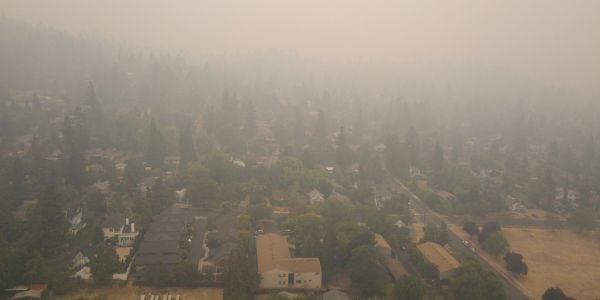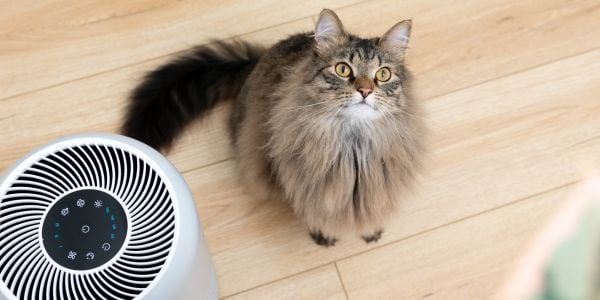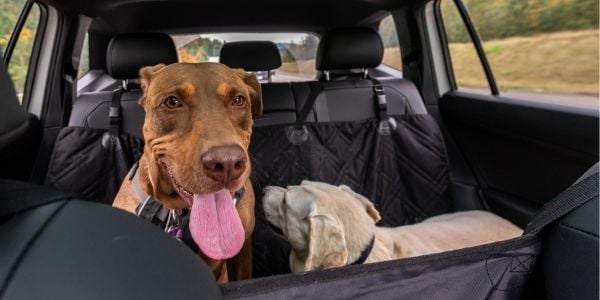 I know first-hand how smoke from a forest fire can impact life.
I know first-hand how smoke from a forest fire can impact life.
A few years ago, a huge forest fire was raging in Colorado.
It got close enough to our home that we could see the flames, and we had a voluntary evacuation order.
Fortunately, the fire was contained, but nothing could be done about its side effects.
The air quality was... well, horrible, and soot fell from the sky, covering everything. Even with limiting time outdoors, our breathing and allergies were impacted.
People can somewhat protect themselves and communicate how things are affecting them. But how can we protect our pets and recognize if they are suffering from smoke inhalation or respiratory distress?
Hopefully, I can help answer those questions.
But I need to say something before we get into ways to protect your pet from smoke in the air. If you live in an area where forest fires are even a slight possibility, PLEASE have an evacuation plan established for your pets in advance, and do not delay evacuating in hopes things will get better. See the emergency checklist below.
While I hope you and your pet are never in danger from wildfires or experiencing smoke inhalation, I hope this article provides some guidance on what to do and look for in order to protect your pets.
How to Protect Your Pet from Smoke in the Air?
The news advises us to stay indoors when the air quality is poor – the same applies to our pets. This is especially true for pets with heart or respiratory issues.
Besides those with known medical issues, brachycephalic breeds (flat-faced pets), puppies and kittens, and senior dogs and cats are at higher risk for inhaling too much smoke.
Short Potty Breaks and No Outdoor Exercise
Keep outdoor cats indoors and keep outdoor bathroom trips for dogs as short as possible. Do not allow outdoor playtime or take your pet on long walks.
Keeping your pet physically and mentally active during these periods is still important, though.
This article will provide you with some great options for indoor exercise for your dog, and this one will help keep your dog's brain active since they can’t be out exploring. Playing using the prey sequence with cats will help keep their frustrations down, and keeping them from getting bored is important too.
Limit Outdoor Air from Coming Indoors
Keep windows always closed. Avoid opening and closing doors as much as possible. Be sure to change air filters more often to be sure they are removing as much air contamination as possible. Consider using room air purifiers.
If you are feeling crafty, you can try making your own air purifier. The video below takes you through the steps to make a DIY air filter for a fraction of the cost of buying one.
But please don't let your pets near or jump on it, as it could collapse, and their fur could get caught in the fan.
After Being Outdoors
If you happen to be outdoors more than advised, be sure not to leave your clothes or shoes where your pet can sniff, lick, and rub on. The smell and soot could cause respiratory issues.
And just like older people and immunocompromised people, senior and immunocompromised pets are less able to filter out particles in the air, which makes their lungs more vulnerable.
Putting Masks On Pets – Don't!
If you were considering putting a mask on your dog to extend their time outdoors, please don’t. The most dangerous aspects of smoke inhalation are carbon monoxide, carbon dioxide, and cyanide.
There is no evidence that masks protect against these. A mask is likely to cause your pet stress if you try to make them wear it, and stress has its own negative impact. Lastly, there is the risk it may be eaten, which will lead to an intestinal obstruction.

How to Know If Your Pet May Have Inhaled too much Smoke?
We can’t always predict when the air will be filled with smoke and when our pets will be at risk of smoke inhalation. Even if we do know, not all pets are indoors or are willing to potty on short trips.
Knowing what the symptoms of smoke inhalation are, is critical. If you notice any of these symptoms, contact your veterinarian.
- Coughing
- Difficulty breathing
- Wheezing
- Lethargy (weakness)
- Decreased appetite and thirst
- Eye issues such as redness, tearing, or continuous blinking. If severe enough, some pets may paw at their eyes, which can result in further trauma (e.g., corneal ulcer)

What Are the Signs of Respiratory Distress?
Knowing the signs of respiratory distress is critical, especially for pets with heart and lung issues as well as for brachycephalic breeds, puppies and kittens, and seniors. Delays in treatment could be fatal.
If your pet exhibits any of these signs, contact a veterinarian immediately:
- Rapid breathing: To know if your pet’s respiratory rate is increased, count respirations. No matter the size of your pet, the average respiratory rate is the same, between 15 and 30 breaths per minute.
- Open-mouth breathing (panting in cats)
- Wheezing
- Standing or sitting upright, with elbows pointed outwards and neck extended
- Bluish colored gums
- Acting distressed or unable to settle
- Collapse
Emergency Preparation
It is important to have contact numbers for facilities that can house your pet in case it is necessary.
I would also recommend keeping an ‘emergency’ bag packed that contains the following:
- Pet food: Pack enough for a week. If you feed your pet canned food, be sure to include a hand-operated can opener.
- Treats
- Collapsible bowls for food and water
- Medical history, including vaccine history and a listing of any medications your pet is receiving
- Medications, enough for two weeks. Be sure to routinely rotate and replace food and medications so that they are not expired.
- Calming and enrichment items
- ThunderEase (dogs) or Feliway (cats)
- Calming treats such as VetriScience Calm & Confident Chews treats for dogs and for cats
- Toys
- Food puzzles
- Small first aid kit
- Poop bags
- Cleaning supplies
NOTE: For cats, be sure to also keep some of their preferred litter in a Ziploc® bag. Some cats will not potty without litter in a box, and others only prefer certain types of litter. Disposable litter boxes are handy to pack.
Another good thing is to have a list of individuals and their contact information in case something happens to you.
Notify these contacts and prepare a Treatment Authorization form so that veterinarians can provide care for your pet in the event you aren't able to take them to the hospital yourself.
I hope you never need to use your emergency plan, but it's a great idea to one just in case.




